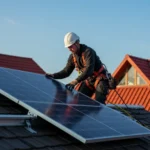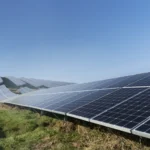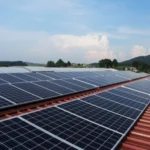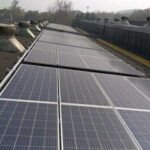Solar Chankya: Complete Guide to Solar Systems and Components
Solar Chankya: Complete Guide to Solar Systems and Components
Solar Systems and Components
MAJOR COMPONENTS:
The major systems, sub systems & components going in a solar power system are:
1. Solar Panels 250W / 300W used in solar power plant for generating solar energy for home/industrial/commercial roof top or ground mounted
2. Module Mounting Structure (customized to requirements)
3. Single/three Phase Solar string Inverter
4. Junction Boxes & ACDB
5. Cables & Accessories
6. Lighting Arresters & Earthing
Solar Panels:
We can use poly or multi crystalline / mono crystalline solar Panels for making a solar power plant for generating solar energy for home/industrial/commercial roof top or ground mounted. But poly or multi crystalline are more viable and makes better sense when cost benefit analysis is done.
The Panels quality needs to be verified before making a decision to buy. Panels with IEC 61215, IEC 61730 and IEC 61701 compliance are considered good. Each module may have 60/ 72 solar cells connected in series depending on what Watt peak panels are being chosen. Each Panel is tested at the supplier premises using Sun-simulator to verify module parameters. The panels are warranted for 25 years energy output with an average 0.8% degradation per year. Module Mounting Structure (customized to requirements).
RCC Roof:
The module mounting structure is custom designed for holding suitable number of panels as per roof space available. The frames and leg assemblies of the module mounting structures are of Mild Steel (MS), suitable sections of Angle, Channel. All hardware considered for fastening modules with this structure are of good quality. The support structure used in the power plants will be hot dip galvanized iron (G.I 80 micron) to avoid rusting over the life time of power plant.
The structure should be such that it is able to withstand wind load of 150 KMPH wind speed at this height in a free standing canopy structure. Structure can be mounted on roof either by bolting to the surface using anchor fasteners or supported on free standing RCC structure. If because of certain obstructions on roof like water tanks , mummty , antennas etc the height of the structure is to be raised to accommodate certain no of panels then such a structure is called elevated structure.
Tin Shed Roof:
In factories/industries most of the time the roof is made of 0.48 mm thick ms sheets may be color coated or GI .In that case structure is designed in a fashion that the load of structure and solar panels is transmitted to the original structure of the industry/ building through the purlins and columns of the original structure.
ARRAY JUNCTION BOX:
Multiple strings formed by suitable number of solar modules in series are connected to string inverter through array junction boxes which are fitted with fuses for over load protection and surge protection devices of suitable ratings.
STRING INVERTER:
Solar Inverter are available in single phase or three phase output mode. It uses Maximum Power Point Tracking charge controller (which enhances solar output) with Grid interactive feature. Solar Photo voltaic panels transforms solar energy into electrical energy as DC power. This DC power becomes input for the solar inverter.
The inverter converts it into conventional AC power; this AC power is fed to the ACDB for use of power in home / industry. Multiple inverters output is clubbed with the help of ACDB and connected to grid supply. These inverters are outdoor type and can be mounted on roof hence no extra space required.
AC Distribution Board:
The AC Distribution Board refers to equipment which consists of MCB/Surge protection devices /Isolator of suitable rating for connecting solar system output to grid with adequate protection.
Cables & Accessories:
Sizes of cables between arrays to Inverter etc. are so selected to keep the voltage drop (power loss) of the entire power plant to the minimum. These cables are insulated with a special grade PVC compound formulated for outdoor use. The skin coloration offers high insulation resistance and long life.
Lighting Arresters & Earthing:
Earthing:
The array structure of the solar panels should be grounded properly using earthing kit. All metal casing / shielding of the plant shall be thoroughly grounded to ensure safety of the power plant. There should be two earthing in any solar plant , one for DC side and another for AC side. It is preferred to earth LA separately for bigger plants.
Lightning protection:
The Solar Power Plant shall be provided for lightning & over voltage protection.
Suggested Articles

Solar Rooftop Subsidy: Why It’s Time for a Change of Mindset
While solar rooftop subsidies help reduce upfront costs, true adoption requires a mindset shift. This guide discusses why businesses and homeowners should focus on long-term benefits, sustainability, and strategic planning beyond relying solely on incentives.

Rajasthan Rooftop Solar Subsidy: What Homeowners Need to Know
Rajasthan homeowners can save big with the 2025 rooftop solar subsidy. Learn about the updated rates, eligibility criteria, and benefits to make your switch to solar more affordable.

China’s Solar Industry Poised for Continued Growth in 2023 and Beyond
China’s solar industry is set for continued growth in 2023 and beyond, driving global renewable energy expansion and technological advancements.

पीएम सूर्य घर योजना 2025 – मुफ्त बिजली पाने के लिए ऐसे करें आवेदन
पीएम सूर्य घर योजना ऑनलाइन आवेदन 2025: मुफ्त बिजली पाने की आसान स्टेप-बाय-स्टेप प्रक्रिया यहाँ पढ़ें।

How to Calculate Battery Capacity for Solar Off-Grid Applications
Sizing a solar battery correctly is vital for off-grid performance and energy independence. This guide explains how to calculate battery capacity, choose the right type, and design a balanced off-grid system for uninterrupted power supply.

Capex vs Opex Solar Model: Which is Better for Your Energy Needs?
Solar energy systems are becoming increasingly popular in homes and businesses around the world. With rising electricity costs, solar energy provides an attractive alternative to traditional energy sources.

Solar Cell Technology: Monocrystalline vs Polycrystalline vs Thin-Film
Explore the different types of solar cells, including monocrystalline, polycrystalline, and thin-film, and learn their efficiency, applications, and benefits for solar energy systems.

How to Improve Solar Panel Performance for Optimal Energy Output
Performance degradation in solar panels reduces energy output over time. This guide explains how to factor in degradation when calculating annual yields, ensuring accurate estimates for residential, commercial, and industrial solar installations.